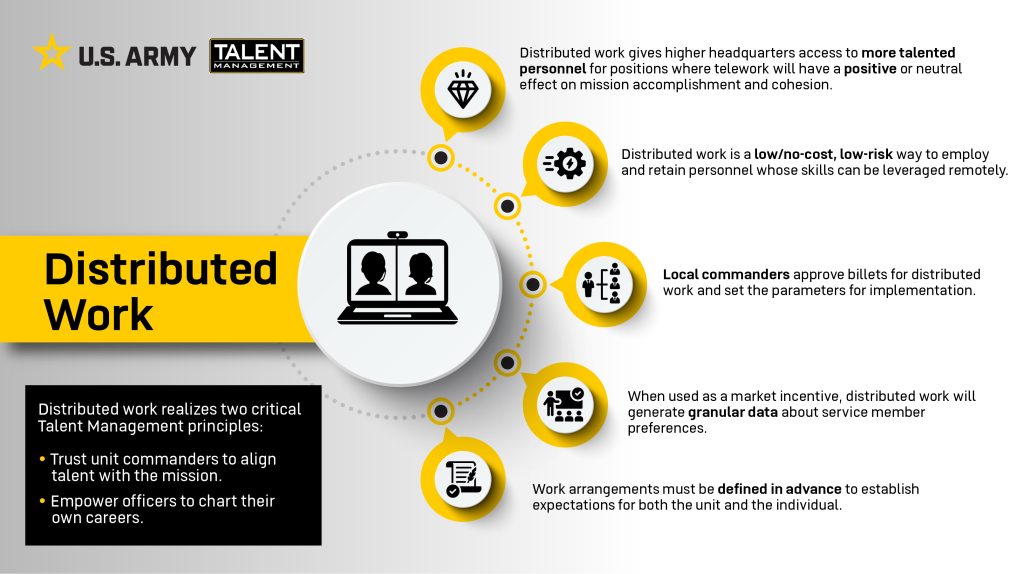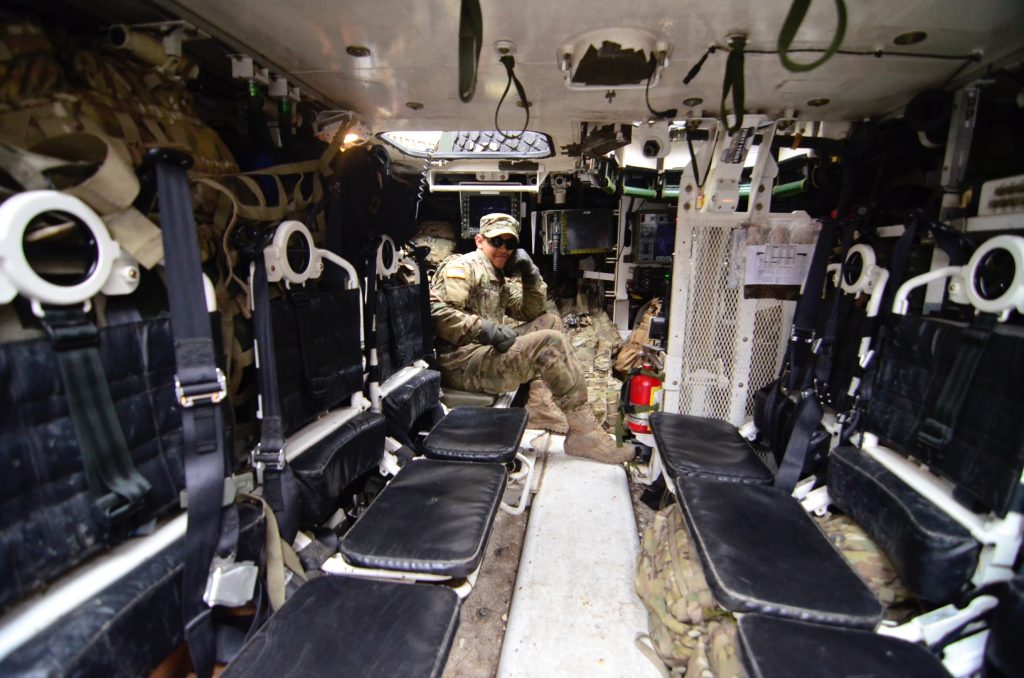
LOCATION BASED CHALLENGES: Service members face a host of location-based challenges to their service, from spousal employment to dual military couple co-stationing, from child care to the high cost of living and available housing. (Photo by George Pak, Pexels)
The Army has a ‘remote’ chance of retaining its best talent, by fixing location-based problems with work opportunities that aren’t location-based.
by Col. Kristin Saling
The COVID-19 pandemic threw the world into chaos. Faced with a worldwide lockdown where proximity to anyone meant the risk of contagion, businesses and institutions reliant on an in-office workforce suddenly found themselves struggling to figure out how to continue work when working out of the office was either impossible or risky. And the DOD cubicle farms that seemed perfectly efficient up to this point were now massive obstacles to safety and productivity.
However, during this time, the Army and DOD began to innovate. Launched into figuring out new ways of doing work, the Army pushed out more digital technology and collaboration tools in the first six months of quarantine than it had since the advent of the internet. And now, three years later, many folks departed the office and haven’t gone back, and are beginning to understand in a way that wasn’t clear before, maybe they shouldn’t go back. Returning to long commutes, stuffy offices and cubicle farms holds little appeal, but even less so for service members where being tied to a location means making a trade-off between career progression and other considerations. By decoupling jobs and location, the Army can reduce this trade-off.
Service members face a host of location-based challenges to their service, from spousal employment to dual military couple co-stationing, from child care to the high cost of living and available housing, from staying near resources essential to those in the Exceptional Family Member Program to facing the hassle and expense of commuting. Many of these challenges can be reduced or eliminated by untethering service members from their locations. Then all that remains is the challenge of teaching an organization that prizes in-person meetings and “butts in seats” how to become more location independent.
MISSION COMMAND AND DISTRIBUTED WORK
Despite the sudden prevalence of these concepts in conversation, remote work, telework and distributed teams are not new. They aren’t even new for the Army. The Army has battalions and brigades spread across small posts in Korea and Germany and operated out of distributed combat operation posts in Iraq, Afghanistan, the Horn of Africa and other locations. Many officers can recount stories of commanding some or all of a small post miles from the flagpole, including signing for buildings and equipment, managing services and garrison functions, and providing command guidance, sometimes as young captains and even lieutenants.
The entirety of Field Manual (FM) 6-0 and Army Doctrine Publication (ADP) 6-0, both titled “Mission Command,” were written expressly to help leaders exercise command and control over often distributed forces to accomplish missions. In the article “Understanding Mission Command,” Col. (Ret.) James D. Sharpe and Lt. Col. Thomas E. Creviston revisited this and emphasized, “The doctrinal terms decentralized execution, decentralization, and empowering agile and adaptive leadership, all imply the same thing—distributed leadership.”
ADP 6-0 “Mission Command” applies a framework that empowers subordinate decision-making and decentralized execution appropriate to the situation that is completely applicable to current methods of working in distributed teams. It was designed for unpredictable and ambiguous environments, and relies on trained, experienced, trusted teams being able to operate independently on a shared understanding of the commander’s intent.
The principles of mission command are:
- Create competence.
- Establish mutual trust.
- Ensure shared understanding.
- Provide clear intent.
- Issue mission orders.
- Prioritize and incentivize disciplined initiative.
- Accept risk.
Commanders who read and apply these principles know how to lead in a distributed environment, whether it’s in a forward combat environment or spread over multiple locations while stateside. One could argue that it also provides principles that should apply to an in-person environment, but in-person environments don’t force the issues of trust, competence and disciplined initiative the way remote and distributed work does.
Distributed work is not for everyone. Not all work can be taken completely online, not all people possess the communication skills, understanding of intent, and disciplined initiative needed to work on a distributed team, and not all commanders possess the traits and behaviors needed to enable this kind of work. Distributed teams often reveal these failings. The good news is that they can be corrected with performance management, mentorship and training.

DISTRIBUTED WORK: The benefits of distributed work. It may not be for everyone, but can be corrected with performance management, mentorship and training. (Graphic by Jimmy Blain, Army Talent Management Task Force and USAASC)
LOCATION INDEPENDENT SOLUTIONS FOR LOCATION DEPENDENT PROBLEMS
John O’Duinn, a renowned expert on distributed teams and distributed work, does not categorize jobs by “remote” or “in-person.” Instead, he focuses on the ties to a location, categorizing jobs as “location-dependent” or “location-independent.” This method of classifying jobs places less focus on the individual receiving the treatment and more emphasis on the nature of work, and how much that work should be done tied to a particular location. Some jobs are tied to particular locations, e.g., jobs involving specialty equipment and machinery such as service depots. Some jobs are tied to the location of the team and the services provided. However, only about 40 percent of Army active-duty positions are at the brigade combat team level and below. A large portion of the Army operates in staff positions working digitally, and those jobs can to a great degree be separated from full-time presence at a given location, even if periodic in-person work and travel are required.
Matching these jobs to competent, disciplined, motivated and communicative individuals has the potential to alleviate a large number of location-based challenges that service members face, many of which drive them to exit service.
- The Married Army Couples Program (MACP). MACP was established in 1983 and provides Soldiers the opportunity to be stationed together while fulfilling the Army’s mission. About 22,000 active component Soldiers are currently enrolled in the program. If both service members are assigned to a duty location supporting the service member whose position is more location dependent, the number of stationing options greatly increases.
- The Army Exceptional Family Member Program (EFMP). EFMP identifies service members with family who have special medical or educational needs requiring support from qualified specialists. This can sometimes make it difficult for a service member to progress their career. Allowing the service member to rotate into location-independent positions can increase opportunities for stabilization and continuity of care while reducing turbulence in the lives of family members.
- Dual professional couples. Surveys show over a third of all Army married couples are made up of two professionals. Even though there have been increases to programs to support employment to military spouses, this population remains critically unemployed or underemployed. This has been the second highest reason cited in the Department of the Army Career Engagement Survey for service members being likely to depart the Army for three years in a row. Location-independent positions, both for service members and professional spouses, allow stability for those in existing jobs or can even allow service members to relocate to support a spouse building a professional portfolio and reputation.
- Compassionate reassignments. A compassionate reassignment allows a service member to get a permanent change of station (PCS) to another duty station in response to a family emergency, hardship or other situation where the Soldier’s presence is warranted. A service member who meets qualifications for location-independent work can be moved and remain assigned to their current position, or remotely assigned to a new location, to better enable the compassionate action request.
- Talent alignment to undesirable locations. This is a benefit well understood by industry, and one that U.S. Army Human Resources Command (HRC) is realizing as the command hires software engineers, data scientists and other technical talent not usually available in Fort Knox, Kentucky’s remote location. Location-independent work allowed the command to both retain talent and make these new hires that might otherwise balk because of family and lifestyle considerations.
Location-independent work and distributed teams also support the retention of individual talent. A service member qualified for a distributed team might take a position remotely where they otherwise might have opted out of the Army to remain in a particular location, to be close to family or a support network, to maintain school locations, or to provide their family general relief from the stress of a PCS. Regardless of the reasoning behind a service member’s interest in stability or location, recruiting talented individuals into distributed teams may allow the Army to retain individuals who might otherwise choose other opportunities. It also allows the leaders of distributed teams to create a competitive environment for competent talent to seek these opportunities.

LOCATION, LOCATION, LOCATION: Some positions are tied to particular locations, e.g., jobs involving specialty equipment and machinery such as service depots, but a large portion of the Army operates in staff positions working digitally, and those jobs can to a great degree be separated from full-time presence at a given location, even if periodic in-person work and travel are required. (Photo by Konrad Ciezki, Pexels)
WAY AHEAD
Remote work programs are still nascent for the active-duty force. The Army is updating policies and regulations to include remote and telework status as duty status updates, and defining the processes for selecting, managing and caring for its remote workforce. Still, the Army adds new organizations to the lists of distributed teams daily. Current organizations piloting programs include Army Futures Command, V Corps, U.S. Special Operations Command, the Army Talent Management Task Force, U.S. Army Human Resources Command, and more. New commands express interest regularly in remote work to retain talented individuals, prompting additional pilots and planned expansion to the effort.
As one major said shortly after HRC announced digital PCS opportunities for remote workers a year ago, “Yesterday, while in my senior rater counseling, we were going over my career timeline. … He said that I should keep an open mind about positions with jobs I want in locations that wouldn’t work for my family because of this program. He said he wouldn’t be surprised if within the next five years, [technical branches] across the Army would be doing this.”
CONCLUSION
While we’ve only looked at one benefit of remote work and distributed teams to service members here, it is a critical one. Even though these programs are nascent, the nature of work and the support of families has proven essential to maintain the trust necessary to continue supporting an all-volunteer force. DOD must continue to embrace solutions like distributed teams and location independence, or else force individuals to decide between supporting their career and supporting their family. While Soldiers personally embrace selfless service and sacrifice, if we ask them to sacrifice needed support for their families, they will find opportunities to serve elsewhere.
For more information contact the U.S. Human Resources Command Public Affairs Office at 502-613-4211 or Col. Saling at 808-783-3279 or Kristin.c.saling.mil@army.mil.
COL. KRISTIN SALING is the director of Army Human Resource Command’s Innovation Cell and serves as the principal adviser to the commanding general on leading technologies and business practices in the people enterprise. She previously served as the acting director of Army People Analytics for the assistant secretary of the Army for Manpower and Reserve Affairs. She holds an M.S. in systems engineering from the University of Virginia and a B.S. in operations research and systems analysis and an active-duty commission from the United States Military Academy at West Point.







